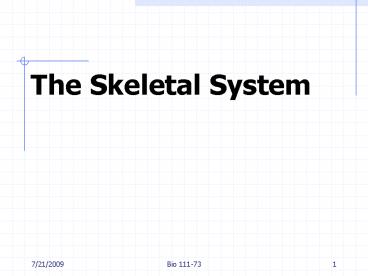The Skeletal System - PowerPoint PPT Presentation
1 / 30
Title: The Skeletal System
1
The Skeletal System
2
Skeletal System
- Bones of the skeleton
- Specialized tissues that connect them
- Cartilage
- ligaments
- Other connective tissue
3
Functions of the Skeletal System
- Support
- Protection
- Storage
- Blood cell production
4
Bone
- Osseous Tissue
- Cells within solid ECM
- osteocytes
- collagen
- calcium deposits
ECM extracellular matrix
5
Bone Shapes
- Long
- Flat
- Short
- Irregular
6
Long Bone Structure
- Gross structure
- Head
- Shaft
typo
7
Long Bone Structure
- Internal
- Bone
- periosteum
- endosteum
- Marrow
8
Long Bone Structure
- External Surface
- Articular Cartilage
- Periosteum
9
Bone Cells
- Osteocytes
- mature bone cells
- Osteoblasts
- bone matrix-forming cells
- Osteoclasts
- bone remodeling cells
10
Bone Types
- Compact
- Spongy
11
Skeletal Development
- Cartilaginous skeleton
- Endochondral Ossification
12
Bone Remodeling
- Allows adaptation
- Osteoclasts work in concert with osteoblasts
- Osteoporosis results when clasts blasts
13
Divisions of Skeletal System
- Axial skeleton
- Appendicular skeleton
14
Axial Skeleton
- Support and protection of organs and organ
systems - Includes bones of
- Skull
- Vertebrae
- Thoracic Cage
15
Skull
- Protects brain
- 22 bones
- Cranium (8)
- Face (14)
16
Cranium
- Bones are held together by sutures (immovable
joints) - Parietal
- Temporal
- Frontal
- Occipital
17
Vertebral Column
- 4 regions
- Cervical (C1 to C7)
- Thoracic (T1 to T12)
- Lumbar (L1 to L5)
- Sacral (5 fused)
- Coccyx
18
Vertebrae
- Spinous process
- Transverse process
- Vertebral foramen
- Body
sp
tp
vf
body
19
Thoracic Cage (Rib Cage)
- Sternum and ribs
- Sternum contains
- manubrium
- body
- xiphoid process
Figure 7-10
20
Ribs-12 pairs
- 1-7 True Ribs
- connected directly to sternum by costal cartilage
- 8-12 False ribs
- 11-12 floating ribs
- Males and females have same number of ribs
21
Apendicular Skeleton
- Movement
- Includes bones of
- Pectoral girdle
- Arm, wrist and hand
- Pelvic girdle
- Leg, ankle and foot
22
Pectoral Girdle
- Clavicle
- Scapula
- Humerus
23
Upper Limb
- Humerus
- Radius (thumb side)
- Ulna (elbow)
- Carpal (wrist) (8 bones
- Metacarpals (hand) (5)
- Phalanges (fingers) (3/finger, 2/pollex)
24
Pelvic Girdle
- Coxa
- Ilium
- Ishium
- Pubis
- Femur
25
Lower Limb
- Femur
- Tibia
- Fibula
- Patella
- Tarsal (ankle) (8)
- Metatarsals (foot) (5)
- Phalanges toes (3/toes, 2/hallux
26
Joints
- Wherever two bones meet
- movable
- immovable (sutures)
27
Structural Types of joints
- Fibrous
- Fibrous joints connect bones without allowing any
movement. The bones of your skull and pelvis are
held together by fibrous joints. The union of the
spinous processes and vertebrae are fibrous
joints. - Cartilaginous
- Cartilaginous joints are joints in which the
bones are attached by cartilage. These joints
allow for only a little movement, such as in the
spine or ribs. - Synovial
28
Synovial
- Synovial joints allow for much more movement than
cartilaginous joints. - Articular cartilage covers bone ends
- Contains
- capsule of dense CT
- meniscal cartilage
- fat pads
- bursa sacs
- Cavities between bones in synovial joints are
filled with synovial fluid. - This fluid helps lubricate and protect the bones.
7/21/2009
Bio 111-73
28
29
Synovial Joints
- Hinge A hinge joint allows extension and
retraction of an apendage. - Saddle A saddle joint allows movement back and
forth and up and down, bot does not allow for
rotation like a ball and socket joint. - Ball and Socket A ball and socket joint allows
for radial movment in almost any direction. They
are found in the hips and shoulders. - Ellipsoid
- Ellipsoid joints are similar to a ball and
socket joint. They allow the same type of movment
to a lesser magnitude. The wrist is an ellipsoid
joint. - Pivot
- Pivot joints allow rotation arround an axis. The
neck and forearms have pivot joints. In the neck
the occipital bone spins over the top of the
axis. In the forearms the radius and ulna twist
arround each other. - Gliding In a gliding or plane joint bones slide
past each other. Midcarpal and midtarsal joints
are gliding joints
7/21/2009
Bio 111-73
29
30
Types of Movement
- Gliding
- Flexion and Extension
- Abduction and adduction
- Circumduction
- Rotation pronation and supination
- Inversion and eversion
- Dorsiflexion and plantar flexion































